Blockchain Weekly | Domestic focus on using blockchain technology to assist in epidemic prevention and control and material distribution Switzerland's first IPO on blockchain approved
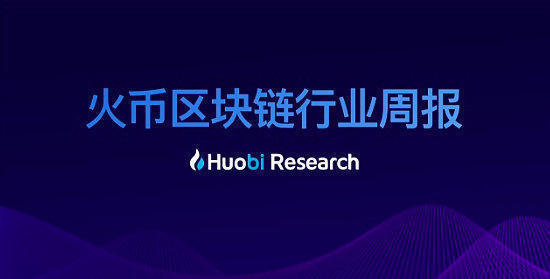
The report produced by the Institute of Fire currency block chain, reports Published February 3, 2020, Author: Yuan Yuming, Rui
Summary:
- Anti-virus, how to win a distributed war?
- Monetary Authority of Singapore: We use distributed ledger technology to solve real-world problems, not technology
- BTC prices are picking up, miners are out of stock, but the mine is empty …
Domestic hotspots:
1. Guangdong Internet Industry Party Committee: Uses blockchain and other technologies to provide the public with information and data services for epidemic prevention and control.
2. Professor of Tsinghua University: The distribution of materials should be introduced into the blockchain and all members of the entire process can be queried. Blockchain technology is fully open, transparent and traceable, and has a promising day in the field of charity.
3. Xinhuanet: Throughout the year, Yuzhong ’s economic work “characteristic development of the blockchain industry” deserves praise.
4. Huobi Charity announced a donation of RMB 10 million. The first batch of personal protective masks has arrived in Huanggang, Hubei. Huobi Group announced that its Huobi Charity will donate 10 million yuan for global procurement of medical supplies to support the epidemic prevention in Hubei. In addition, 20,000 personal protective masks it purchased have been delivered to Huanggang City, Hubei Province.
Industry applications:
1. Mercedes will use blockchain to track carbon emissions in the cobalt supply chain. Major automaker Mercedes-Benz and blockchain startup Circulor are jointly launching a pilot project to track carbon emissions in the cobalt supply chain.
2 . Ditto Music launches an app that provides a fast blockchain solution. Music company Ditto Music will launch Bluebox, an application that provides blockchain recording technology, which may bring good news to musicians and publishers.
3. Block chain + smart agriculture: Shandong Hexiansheng Agricultural Technology Co., Ltd. model of modern agricultural blockchain reform.
International policy:
1. The National Bank of Cambodia will launch a digital payment network this quarter . The new digital currency of the Cambodian National Bank is called Bakong. It is actually a central bank digital currency (CBDC) and will be piloted throughout Cambodia in July.
2. The Swiss company is preparing a compliant IPO on the Ethereum blockchain. Swiss regulators have approved what is said to be the country's first fully compliant blockchain initial public offering (IPO).
3. India's draft national distributed ledger technology strategy calls for the introduction of a state-run digital rupee.
Technical progress:
1. Hyperledger Fabric supported by IBM has released version 2.0. The platform adds several major features that can improve the way communication between its different participants.
Bitcoin hashrate has risen this week. Bitcoin mining difficulty this week has increased, the average size of Bitcoin blocks this week has increased, and the average number of block transactions has increased; Bitcoin miner fees have increased this week;
According to the calculation of blockchain.info data, as of February 2, the total number of blockchain wallet users reached 45,491,346, an increase of 0.44% compared with last week.
RDN is the most active github code project this week. From January 27, 2020 to February 2, 2020, RDN was the most active in github code, with a total of 67 commits this week.
A total of 2 investment and financing projects in the blockchain industry were counted this week. Optimism receives seed round investment from "Paradigm and IDEO" and Bit Trade is acquired by "Kraken".
Report body
1. Blockchain Weekly News
1.1 Domestic Hotspots
1. Guangdong Internet Industry Party Committee: Uses blockchain and other technologies to provide epidemic prevention and control information and data services to the masses
According to Sina Finance News, the Internet Industry Party Committee of Guangdong Province released on January 31 "The full use of the role of party organizations and party members, cohesion and victory in epidemic prevention and control and blocking war", the article mentioned that party organizations in information service enterprises should use big data Technical means such as blockchain and block chain will provide comprehensive, accurate and objective information and data services for epidemic prevention and control to decision-making agencies and the general public. China is fighting Wuhan's new type of coronavirus pneumonia, but it is a bit chaotic. We should use the latest technology to win the epidemic. Maybe the blockchain can play a role in it.
2.Professor of Tsinghua University: The distribution of materials should be introduced into the blockchain and the entire process can be queried by all members.
Professor of Tsinghua University School of Journalism and Communication, Weibo Da V "New Media Shenyang" issued a Weibo on the issue of new pneumonia materials, essentially the distribution of materials and the push of information are similar. Information push today has come to the age of intelligent recommendation, and the distribution of materials should also introduce AI, blockchain, cloud computing and big data (ABCD), and all members of the entire process can query it. Looking forward to this day. Recently, the Wuhan Red Cross Society is very troublesome. Blockchain technology has full openness, transparency and traceability, and it has a promising day in the field of charity.
3. Xinhuanet: Throughout the year, Yuzhong ’s economic work “characteristic development of the blockchain industry” is worthy of praise
Recently, Xinhuanet published an article "Nine Highlights" highlighting the high-quality development of Yuzhong's economy while seeking steady progress. The article points out that in 2019, Yuzhong District of Chongqing City adheres to the general tone of progress in stability, adheres to maintaining stability and promotes growth, strives hard and works effectively, the core area advantage is further highlighted, and high-quality development achieves a new leap forward. Throughout the year's economic work in central Chongqing, there are "nine highlights" worthy of praise. This includes "characteristic development of the blockchain industry." Chongqing's blockchain industry innovation base is operating well, and more than 40 companies have settled in. According to the "2018 China Urban Blockchain Development Level Assessment Report", the base's comprehensive competitiveness ranks fifth in the country and enters the first echelon. The Blockchain Summit Forum of the Expo was held in Yuzhong again, with more than 240 companies participating, and the city took the lead in achieving continuous outdoor 5G signal coverage.
4. Huobi Charity announced a donation of RMB 10 million. The first batch of personal protective masks has arrived in Huanggang, Hubei.
On January 27, Huobi Group announced that its Huobi Charity will donate 10 million yuan for global procurement of medical supplies to support the epidemic prevention in Hubei. In addition, 20,000 personal protective masks it purchased have been delivered to Huanggang City, Hubei Province. . Huobi said that in the future, 200,000 sets of medical protective materials will be delivered to areas with severe epidemics. Huobi Group's founder Li Lin revealed that he has called on office staff in more than a dozen countries to look for procurement channels and purchase medical supplies such as masks, disinfectants, goggles, and protective clothing, which are in short supply for patients, front-line medical staff, and the government. The department provides support.
1.2 Industry Applications
1.Benz will use blockchain to track carbon emissions in cobalt supply chain
Major automaker Mercedes-Benz and blockchain startup Circulor are jointly launching a pilot project to track carbon emissions in the cobalt supply chain. According to a January 30 news report, the project between Mercedes and Circulor is part of the Startup Autobahn program, which aims to confirm the production of the next generation of cars. The two companies will deploy blockchain to track climate-related gas emissions and the amount of recycled materials in the complex supply chain of battery manufacturers. The blockchain-based pilot project will show in detail the production process of these raw materials and the carbon emissions generated during the process, and record the use of recycled materials in the supply chain.
2. Ditto Music launches app that provides fast blockchain solutions
Music company Ditto Music will launch Bluebox, an application that provides blockchain recording technology, which may bring good news to musicians and publishers. Bluebox will address artists' legal issues such as copyright registration, publishing and mechanical division. The app records music according to a legally binding smart contract, which is written into the code and immediately protects the copyright of the creative content. Ditto Music CEO Lee Parsons said: "There are billions of dollars of royalties in Ditto Music that are not claimed by the owner. Blockchain can help millions of artists get what they deserve." Parsons believes this will bring With greater transparency and more detailed data reporting, both will gain higher acquisition rates from digital services.
3. Blockchain + Smart Agriculture: A model of modern agricultural blockchain reform in Shandong Hexiansheng Agricultural Technology Co., Ltd.
The goal of "Blockchain + Smart Agriculture" is to build a safe and reliable food platform, so that suppliers producing good things can sell for a good price, and consumers who are willing to pay for food safety can buy safe food. From crop production, circulation, warehousing to terminals, the blockchain can complete the "secure transmission" on this series of chains. Shandong Hexiansheng Agricultural Technology Co., Ltd. has applied the "blockchain + smart agriculture" application technology to move agricultural products from the production end to the circulation end, and uses the blockchain to keep records that cannot be tampered with. As a result, farmers have detailed growth data, processors have specific production data, distributors have accurate inventory data, regulatory agencies have rigorous safety data, retailers have detailed distribution data, and consumers have practical food chain codes. data. The blockchain allows Shandong Hexian Agricultural Technology Co., Ltd. to provide more comprehensive guarantees for food safety.
1.3 International policy
1. National Bank of Cambodia to launch digital payment network this quarter
The new digital currency of the Cambodian National Bank is called Bakong. It is actually a central bank digital currency (CBDC) and will be piloted throughout Cambodia in July. Chea Serey, Director General of the National Bank of Cambodia, said: "Bakong will play a central role in bringing all participants in the Cambodian payments sector into one platform, enabling end users to be no matter which bank they are in When opening an account, you can easily pay each other. Finally, we want to allow cross-border payments through the Bagong system. "Unlike most blockchain-driven cryptocurrencies, Bakong is a closed system supported by banking authorities. Software wallets connect to each user's bank account, making it easier for them to interact with hard currency. The system supports real-time transactions, while the National Bank of Cambodia stores centralized record data on the flow of funds.
2. Swiss company prepares for compliant IPO on Ethereum blockchain
Swiss regulators have approved what is said to be the country's first fully compliant blockchain initial public offering (IPO). Swiss blockchain company Overture released a press release on January 29th, which will use smart contracts provided by EURO DAXX (European Digital Asset Exchange) based in Zug (Central and Northern Switzerland) to launch on the Ethereum blockchain Comply with the IPO and issue ordinary A shares on the Ethereum blockchain. They claim that deploying blockchain technology in this way can improve the efficiency of the capital market, including time costs and other aspects of efficiency, which will be achieved by participants (ie banks, broker-dealers, central deposit systems, notaries and other financial institutions). Direct intermediary agencies) to ensure deintermediation.
3. India's draft national distributed ledger technology strategy calls for state-run digital rupees
India's draft national strategy on blockchain and distributed ledger technology proposes the concept of a central bank digital currency (CBDC), Indian digital rupee, and national blockchain. The National Intelligent Governance Institute (NISG), a non-profit public institution established by the Indian government, has released a draft of India's national blockchain strategy document. In this document, NISG proposed the concept of the Central Bank's Digital Rupee (CBDR), a digital currency issued on a state-licensed blockchain. A few days ago, the Bank of India stated that virtual currencies were not banned in the country, but in detail, regulated entities were banned from providing crypto asset business in the country. According to reports, the Bank of India banned Indian banks from providing cryptocurrency-related services in India in 2018.
2. Technical capability analysis
2.1 Blockchain Technology Progress
1. IBM-backed Hyperledger Fabric releases version 2.0
According to an enterprise announcement on January 30, Hyperledger Fabric updated version 2.0 of its enterprise distributed ledger technology (DLT) platform. The platform adds several major features that can improve the way communication between its different participants. The 2.0 version of Hyperledger Fabric has made some significant improvements to the decentralization of the network by adding a new management system for chaincode, which is Fabric's smart contract term. Now, multiple organizations can agree on the key parameters of the chaincode and then use it to share the ledger. In addition, the chaincode can be adjusted by a single organization and then submitted to the ledger to ensure that everyone agrees on what data can be shared with each other. At the same time, data sharing has been simplified to work on a need-to-know basis. Businesses now have the option to share data privately with specific members of the instant network, eliminating the need to define complex channel combinations to perform the same operation. Finally, the announcement also introduced several performance improvements, including task parallelization and more efficient program flow. Hyperledger claims this enables the network to support thousands of transactions per second.
2.2 Analysis of Difficulty and Benefits of Cryptocurrency Production
Bitcoin hashrate has risen this week. From January 27, 2020 to February 2, 2020, the average hashrate of the entire Bitcoin network was 111.6 EH / s, which was 0.90% higher than last week.
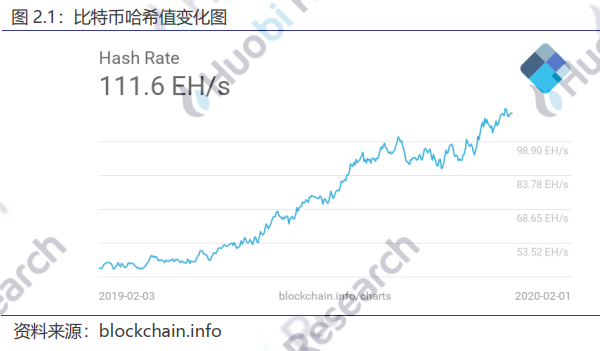
Bitcoin mining difficulty has increased this week. As of February 2, 2020, Bitcoin's mining difficulty this week remained at 15.13T, which was an increase of 2.44% from last week.
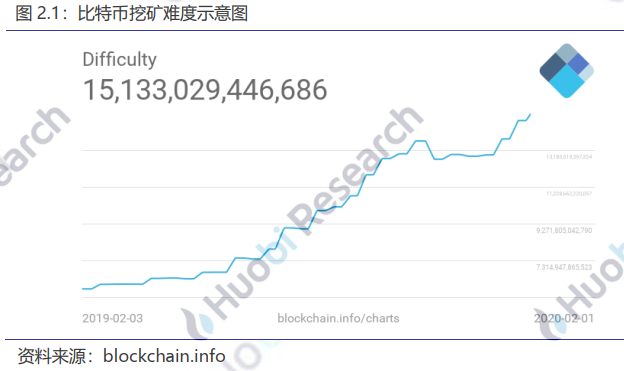
The number of blocks generated by the entire Bitcoin network fell by 4.46%, and the top five rankings have changed from last week. The number of blocks generated by the entire network of Bitcoin over the past week was 1,028 blocks, a decrease of 4.46% from the previous week, of which the top five were F2Pool. , Poolin, BTC.com, AntPool, ViaBTC produce blocks 189, 167, 124, 111, 75 respectively, accounting for 18.39%, 16.25%, 12.06%, 10.80%, 7.30%, and computing power of 20.52 EH / s, 18.13EH / s, 13.46EH / s, 12.05EH / s, 8.14EH / s.
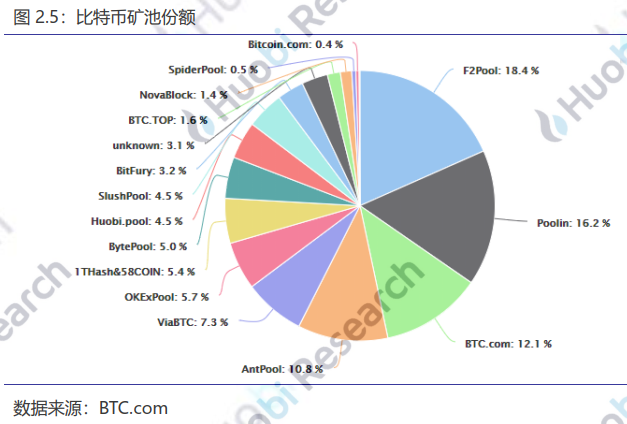
2.3 Activity Statistics
This week, the average size of Bitcoin blocks increased, and the average number of block transactions increased . According to the data calculated by blockchain.info, from January 27, 2020 to February 2, 2020, the average size of each block of Bitcoin this week was 1.01MB, which was an increase of 1.69% from the previous quarter. The average number of transactions per block was 2101 times, an increase of 1.84%.
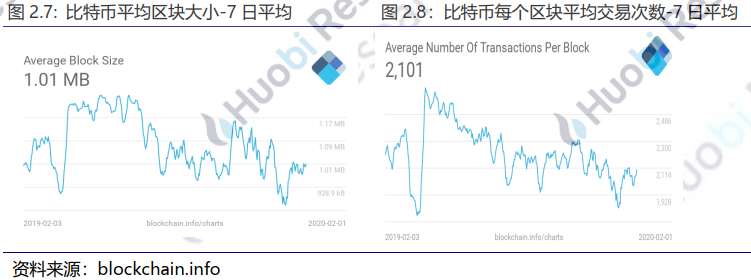
The average number of unconfirmed transactions in Bitcoin this week rose 66.74%. As of February 2, 2020, the average number of 7-day unconfirmed transactions in Bitcoin was 6,928, an increase of 66.74% from the previous quarter.
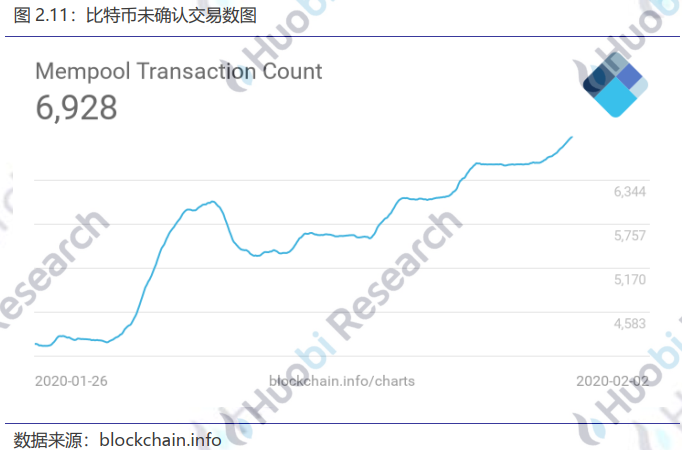
This week, Bitcoin miner fees rose and Ethereum miner fees rose. As of February 2, 2020, Bitcoin ’s average daily miner fee was 0.541USD, a 62.46% increase from the previous month, and Ethereum ’s miner fee was 0.0917USD, a 14.29% increase from the previous month.
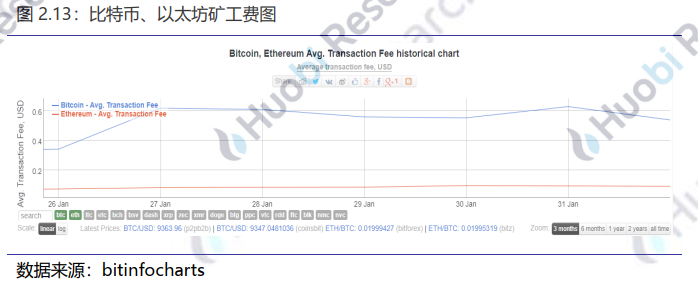
The number of Bitcoin verification nodes rose month-on-month. As of February 2, 2020, the number of Bitcoin verification nodes reached 11045, an increase of 1.05% month-on-month, of which 2354 nodes in the United States, accounting for 21.31%; Germany has 1849 nodes, accounting for 16.74%; China ranked ninth, has 239 nodes, accounting for 2.16%.
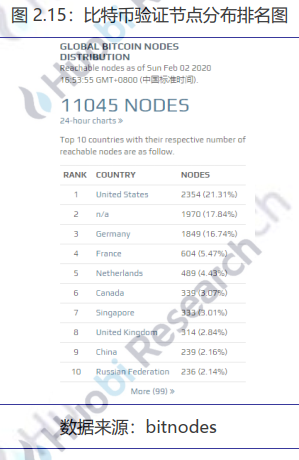
Bitcoin users this week are compared to last week and last week. According to the data calculated by blockchain.info, as of February 2, 2020, the total number of blockchain wallet users reached 45,491,346, an increase of 0.44% from last week.
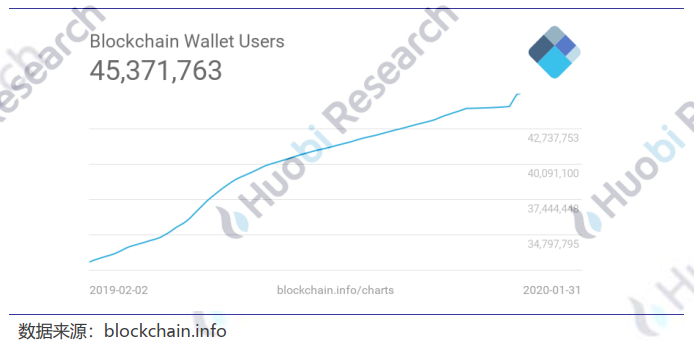
RDN is the most active github code project this week. From January 27, 2020 to February 2, 2020, RDN was the most active in github code, with a total of 67 commits this week.
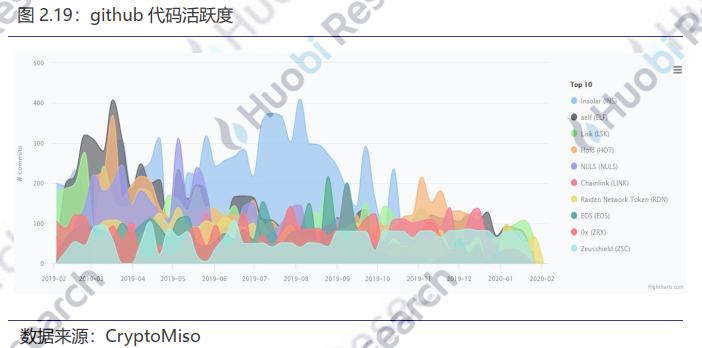
3. Investment and Financing Trends in the Primary Market
A total of 2 investment and financing projects in the blockchain industry were counted this week . Optimism receives seed round investment from "Paradigm and IDEO" and Bit Trade is acquired by "Kraken".
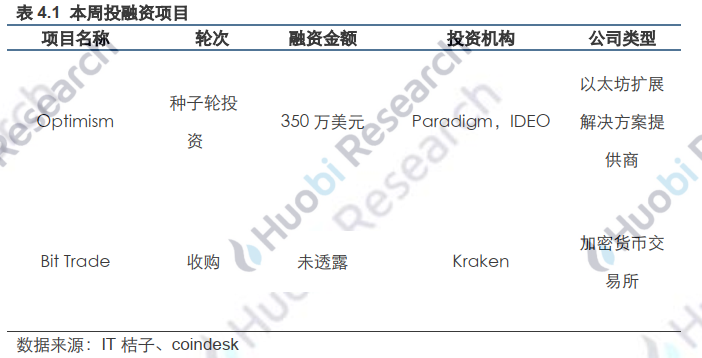
Huobi Blockchain Application Research Institute
about us:
The Huobi Blockchain Application Research Institute ("Huobi Research Institute") was established in April 2016. Since March 2018, it has comprehensively expanded research and exploration in various areas of the blockchain. The main research content includes the blockchain field. Technology research, industry analysis, application innovation, model exploration, etc. We hope to build a research platform covering the complete industrial chain of the blockchain, provide a solid theoretical foundation and trend judgment for the blockchain industry people, and promote the development of the entire blockchain industry.
Huobi Blockchain Industry Weekly Report is a weekly report on the blockchain industry launched by Huobi Research Institute. The report mainly includes a review of the overall market, the performance of major projects, the analysis of technical capabilities such as the status of digital asset production and code updates, as well as a detailed review and review of blockchain industry news and the development of primary market projects. Investors grasp the overall pulse of the market in a timely and fast manner, keep up with development trends, and understand the latest developments of the industry in a variety of analytical dimensions.
contact us:
Email: [email protected]
Jianshu Public Account: Huobi Blockchain Research Institute
Twitter: Huobi_Research
Disclaimer
1. The Huobi Blockchain Research Institute does not have any associated relationship with the digital assets or other third parties involved in this report that affects the objectivity, independence, and fairness of the report.
2. The information and data cited in this report are from compliance channels, and the source of the information and data has been deemed reliable by the Huobi Blockchain Research Institute, and necessary verifications have been made on its authenticity, accuracy and completeness. , But the Huobi Blockchain Research Institute does not make any guarantee for its authenticity, accuracy or completeness.
3. The content of the report is for reference only, and the facts and opinions in the report do not constitute any investment advice for related digital assets. The Huobi Blockchain Research Institute does not assume any responsibility for losses caused by the use of the contents of this report, unless expressly provided by laws and regulations. Readers should not make investment decisions based solely on this report, nor should they lose the ability to make independent judgments based on this report.
4. The information, opinions and speculations contained in this report only reflect the judgments of the researchers on the date of finalizing this report. Based on industry changes and data information updates in the future, there may be updates of opinions and judgments.
5. The copyright of this report is only owned by the Huobi Blockchain Research Institute. If you need to quote the content of this report, please indicate the source. If you need a large reference, please inform in advance and use it within the allowed range. Under no circumstances shall this report be quoted, abridged, or modified in a way that is contrary to its original intent.
We will continue to update Blocking; if you have any questions or suggestions, please contact us!
Was this article helpful?
93 out of 132 found this helpful
Related articles
- Is Bitcoin price increase affected by coronavirus?
- Donations are in doubt, and the charity fund blockchain is imminent | Witness
- On-chain transaction linkage market rose by 46%. The number of large transfers or the leading indicator?
- Cryptocurrency-related issues are included for the first time in U.S. tax forms, IRS: Cryptocurrencies remain the focus of 2020
- Watch | Brexit wishes come true, can BTC skyrocket?
- Zhu Jiaming: Rethinking about industrial blockchain: Although the blockchain industry has made progress, it is expected to be much slower
- Global central bank digital currencies accelerate, DCEP development process inventory






